Figure One. Crop Circle at Clear Wood, Upton Scudamore, Wilts.
Latitude : 51°N 13′ 36″; Longitude : 2°W13′ 29.6″
Robin Heath is an independent researcher into the surviving evidence that supports those ancient sciences that modern scientists have chosen to ignore, for whatever reasons. Once a research scientist in semiconductors, he became a lecturer in electronics and mathematics in further education, before taking up his present work. He lives in coastal West Wales with his wife Trish. Robin may be contacted via his website www.robinheath.info.
You can listen to Robin discuss his work and some of the material in this article on the the Temporary Temples Podcast.
When crop circles and stone circles meet
This curious tale began innocently enough, and went on to reveal a wholly unexpected connection between stone circles and crop circles. For anyone who thinks that these two phenomena would not make good bedfellows, this article demonstrably suggests otherwise.
The narrative described here began on August 3rd, when crop circle researcher Guenther Schermann delivered a lively talk at the Summer Lectures, in Devizes. He let drop a single piece of information that caught my attention, concerning a new crop circle formation that had appeared near Warminster on the 28th July 2019 at Clear Wood, near Upton Scudamore. This crop circle’s outer annulus, he had been informed by researcher Prof Jonathan-Paul DeVierville, contained a pattern of 153 woven divisions. Aha, I thought!
The number 153 is familiar in my work on soli-lunar calendars and sacred geometry, but to my knowledge it has never been a key factor in the design of a crop circle. Steve Alexander’s crisp photograph of this crop circle (Fig one, above), shows the outer annulus or ring of flattened crop carefully laid down to reveal the 153 repeated patterns running around its circumference. I made a mental note to measure this circle, assuming without any evidence that it might reveal something else rather special within its geometric design, for 153 means something very significant to an astronomer or sacred geometer. 153 is the number of fishes caught in the net in St John’s gospel, but it is also almost exactly the square of the number of lunar months in one year – which is 12.368*. Why is this so significant? Better read on!
[* My dear friend Pedanticus tells me that the number should be 12.36826626, being the division of 365.2422 by 29.53059. The square root of 153 is 12.36931688, both numbers falling within 99.9915% of being identical, or 85ppm.]
Working as a megalithic scientist, I have been locating examples of prehistoric monuments that display an integration of astronomical, geometrical and metrological qualities. I survey or otherwise measure prehistoric stone monuments prior to, in addition, investigating if a monument is connected to its neighbours, astronomically, geometrically (or geodetically) and metrologically.
Archaeology presently shows no interest whatsoever in these kinds of investigative measurements. No matter, for archaeology’s ossification has left the field wide open for me to get on with pioneering what has proved a most rewarding methodology, one that has provided that long sought after reason for the function of many megalithic structures – and why these monuments were located where they were. Since 2010, I have become increasingly able to identify a previously unsuspected linkage or mechanism that connects prominent sites over long distances. More recently (2018) these same techniques have proved applicable to crop circles, in certain circumstances.
Earlier this year, I was asked by Karen Alexander to deliver a presentation at this year’s ‘Summer Lectures‘ event, to explain my recent research findings and to demonstrate how one may learn to ‘read’ the megalithic ‘language’. Sunday August 4th at 2:30pm was to be my time-slot. During the week of the 28th July, the date when the Clear Wood circle was first reported, I was beavering away preparing my presentation slides for the Summer Lectures weekend on 3-4th August. My presentation was, rather adventurously I thought, entitled Ancient Aliens or Stone Age Einsteins?, the strapline being Evidence for an Advanced Prehistoric Science. The opening slide is shown below (Figure two).
During this talk I announced for the first time significant information that had become apparent during detailed research earlier in 2019 in the Preseli region of West Wales. A newly revealed 5-12-13 ‘Pythagorean’ triangle was shown to connect several very well known megalithic sites. This triangle, which I’ve since named the St David’s triangle, was very large, and a Google earth map showing the area over which it spans was planned to be the final slide of my ‘show’. This proved prescient, for it has more than shown itself to be ideally matched to this event.
Marrying the Sun and the Moon
We will return to this discovery later. First I need to explain how a 5-12-13 triangle, and the subsequent lunation trianglethat can be derived from it, enable an integration to take place between the motion of the sun and that of the moon. In other words, a lunation triangle (Figure three, below) marries the sun and moon, not alchemically, but astronomically, using geometry and ratio alone.
A geometrical process by which the solar year can be automatically calibrated in lunar months, using a simple template that requires only ropes marked into pre-selected equal intervals, and pegs. The construction is laid out on the ground.
In one complete year there are neither 12 nor 13 lunar months, but a seemingly awkward in-between fractional number, 12.368 lunar months. Remember this!
A ‘solar’ year is 365.2422 days in length and the average long-term value for the ‘lunar’ month is given as 29.53059 days. Divide one by the other and the annual lunar rate of 12.368 lunations or synodic lunar months is revealed.
The 3:2 point on the ‘5’ side of the above triangle provides a unique location where a line may be drawn to the apex of the triangle such that its length (of time) then represents the solar year already calibrated into 12.368 lunar months, accurate to better than 99.99%. Dividing the ‘5’ side into the ratio 3:2 would, in a stringed instrument, provide the most harmonious interval of the scale, a musical ‘fifth’.
A reader might have good reason to be elated to discover that this simple geometrical template can describe the order inherent in the major motions of the sun, moon & earth system, an order presently denied by the high priesthood of Science. Everyone likes a happy marriage.
THE TIMELINE OF EVENTS
On Saturday August 3rd, Gunter Sherman delivered his talk at the Summer Lectures and tells his audience that there is this crop circle at Clear Wood near Upton Scudamore which has a perimeter with 153 woven divisions. [12.369 squared, remember?]. Later that day, Philippe Ullens from The Henge Shop at Avebury takes his oblique photograph of the formation from a microlight (see figure five).
On Sunday August 4th 2019, I deliver a Powerpoint supported presentation about the St David’s triangle, a premiere, and reveal its significance as the ultimate form that stores what it was built to do as a calendrical soli-lunar template, by using a unit length of 12,368 feet, a thousand times the number of lunar months within one solar year.
On Monday August 5th Trish and I go to the Crop Circle exhibition at Honey Street, near Alton Barnes, where we meet director Monique and the American psychologist and crop circle specialist professor Jonathan Paul de Vierville, who provided me with a solution. A young couple, Jess Best and his partner Rebecca, were talking with Jonathan at the Exhibition… about investigating the plan of the Clear Wood circle and talking about visiting that formation on their way home to Manchester that same evening. Hmm!
Enter the Measurers – Jess and Rebecca
This was Jess and Rebecca’s very first encounter with the Crop Circle phenomenon. I talked awhile with this couple and then I asked them if they’d mind doing a bit more than just wandering around at the Clear Wood site? Would they be happy to measure its key dimensions? Jess immediately agreed to measure the circle and assured me that he knew how to wield a 100′ tape measure, and my earlier problem appeared solved. It was to be the first ever crop circle the couple had visited! They did not let me down.
On Tuesday August 6th I had to be on site at The Henge Shop at Avebury by 8am, to be interviewed, bleary eyed, by a TV crew working for a branch of the History Channel, a popular TV program in the US and elsewhere and today preparing a documentary about stone circles. At 7am, I found an email from Jess and Rebecca with the measurement data. Although I had really wanted to go and survey the circle in person, Jess and Rebecca had done the job for me. I now had enough data to begin analysing the Clear Wood formation (see figure six). The measurements were in the bag.
Crop circles are temporary temples, as soon as they are made they start to deteriorate, albeit slightly but inexorably. Figure five (below) shows the effects of two days on the Clear Wood formation, where crop trampling and visitor creep become clearly visible, just two days after the formation was first reported. Compare this with Figure One and play spot the differences, or see if you can identify which thoughtless Wally walked across the crop instead of using the tramlines conveniently provided!
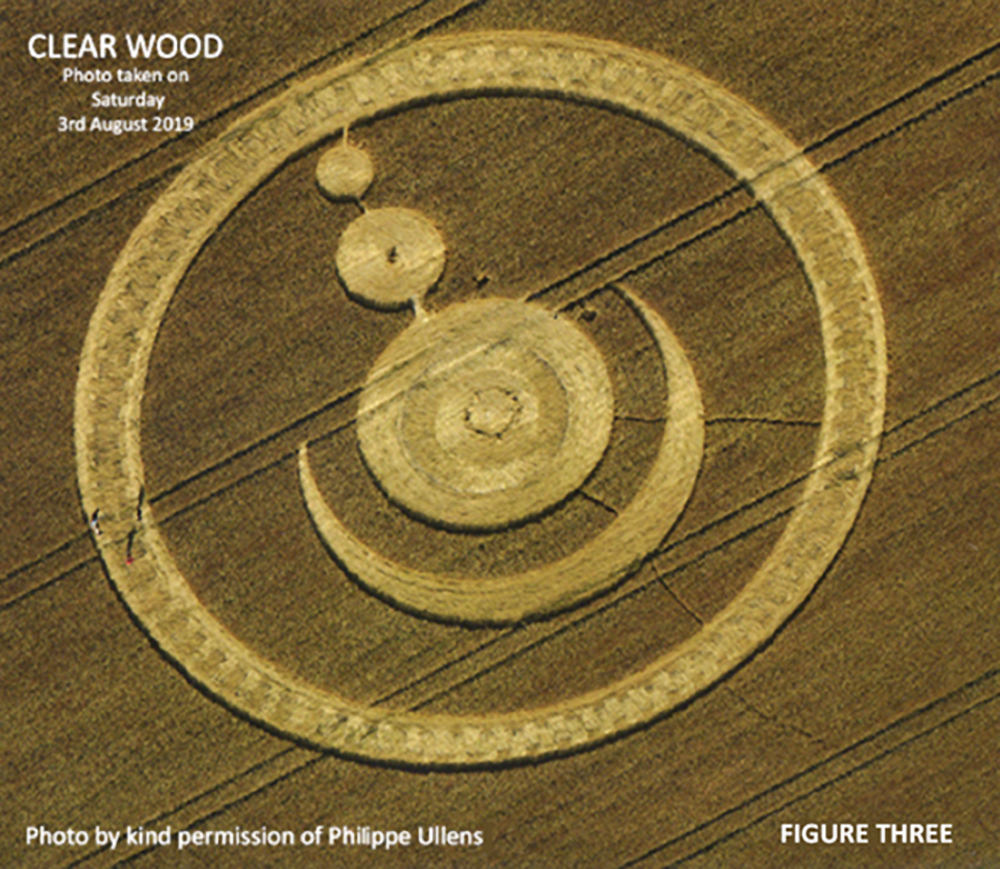
Figure Five. An oblique photograph of the Clear Wood formation.
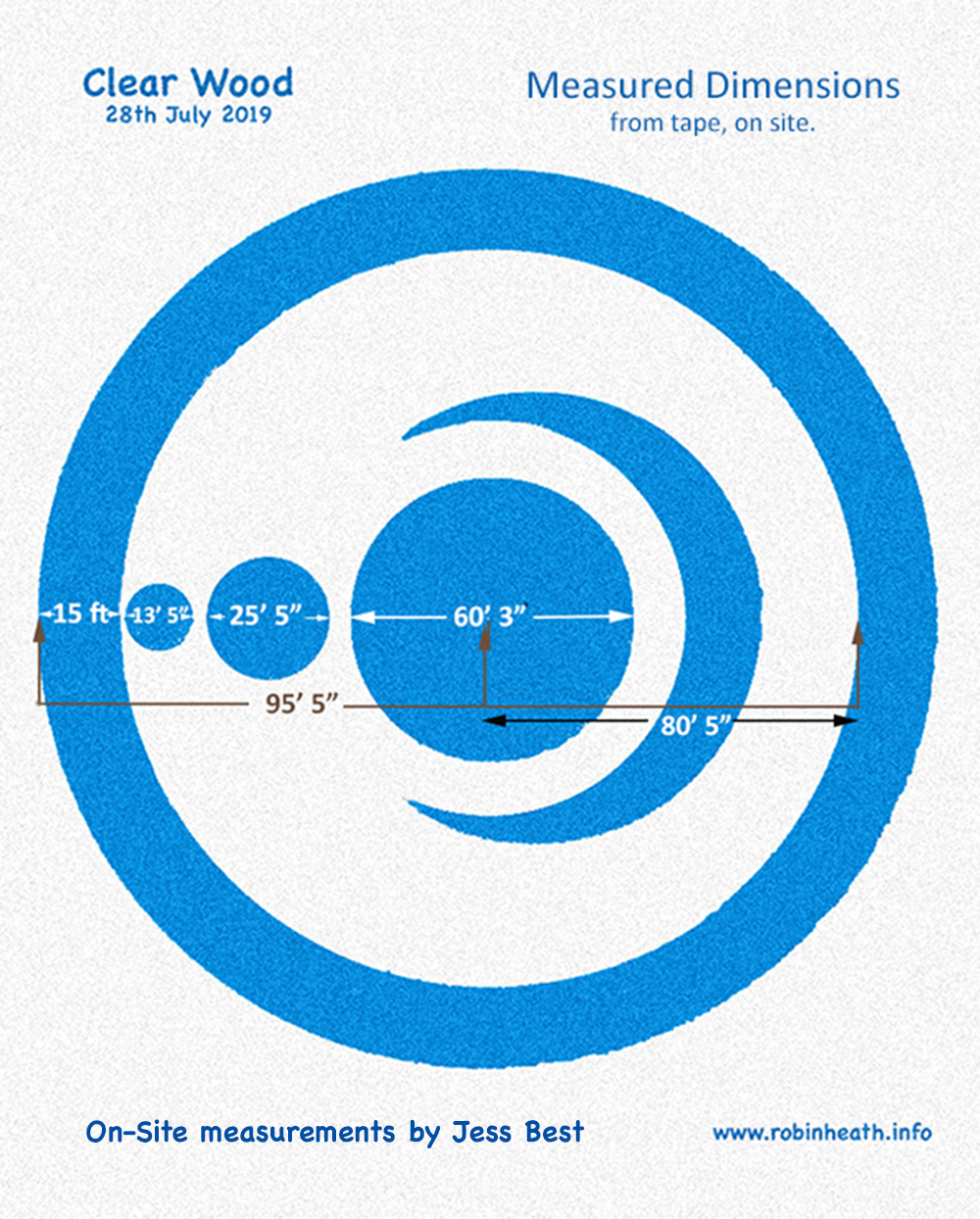
Figure Six. On site tape measurements at Clear Wood formation.
TEMPLES, TEMPLATES AND TEMPLARS
Stone monuments are much more robust than those etched within growing crops, and the survivors have proved, by definition, to be enduring, even permanent temples. The lunation triangle previously described is a template or ‘little temple’. Human civilizations dating back into the opaque fog of prehistory have all built sacred monuments, temples to their gods, and a very long history exists concerning what does and what does not comprise a temple. However, all sacred temples are designed to offer a single main purpose – that of connecting or drawing down the heavens, the above, onto the earth, the below, to connect sky to earth and thereby God to Man. As above, so below.
A traditional temple is filled with geometrical ideas, and metrology and number, and it will contain much astronomical and astrological symbolism, especially relating to the sun and the moon. Many of the finest Gothic cathedrals in Europe, such as Chartres or St Samson of Dol, built under the aegis of stonemasons or the later Templars, began with the building of two large towers, either side of what would become the main entrance. One tower would be dedicated to the Sun, the other to the Moon. Two of Britain’s most important ‘national’ temples, Stonehenge, and Avebury, the largest stone circle in the world, are similarly concerned with observing, recording and storing solar and lunar cyclic rhythms.
I have never had any issue mixing my stone circle work with my crop circle interests. Their differences may appear massive to the non-specialist, yet both structures are essentially monuments or temples, and both are readily measurable and essentially geometric in nature. Both crop and stone circles reveal themselves to be the products of some particularly evolved and high levels of consciousness. Without that high level of consciousness they would not have the same impact as mandalas. There may be a fine geometric design present, but not the panache, ‘buzz’ or ‘trace’ one gets from studying many of the best crop circles. Some of these crop formations are very cool indeed.
Crop circles can affect your mind and they can teach you a thing or two. But whoever or whatever makes these formations matters far less to me than does ‘reading’ any message that may be encrypted and stored within the formation. One message emerging from this story is the need for croppies to become better at reading the message embedded in the crop formations.
ANALYSING CROP CIRCLE FORMATIONS
A plan of the Clear Wood formation is shown (in figure six), with Jess’s taped measurements superimposed. The plan of the formation (Figure one) is derived from Steve Alexander’s overhead photograph.
The design is complex and it required a long session with a calculator to reveal its essence, working directly from a large computer screen. I was fortunate to have obtained two separate plans of the circle, one derived from an overhead shot of the design in its field, taken by Steve Alexander, the other a black and white drawing kindly and generously supplied by Michael Glickman. Paper copies of both plans were compared and reproduced, using dividers and a steel rule, each with a scale of 1cm = 10 feet. My big drawing board was on overtime.
Nothing in the physical world can ever be 100% perfect, and despite their apparent perfection and their other-worldly qualities, crop circles are no exception to this. So, how accurately can crop circles be measured, and what does measuring a crop circle entail? A crop design in a field of windblown crop cannot ever be 100% stable. There are tolerances to be considered, so how accurate might one expect these often complex geometrical designs to be? Then one must address how accurate the measuring tape can be and what ability must the measurers possess in order to read from it correctly? Measures read from a tape need to be undertaken within a few days of the design manifesting in the field,. A raggedy wind-blown trampled specimen may not provide the originally intended dimensions or geometry of the design.
I have dealt with the same kind of metrological challenges all through my time as a professional research engineer and latterly at megalithic sites. Solid stone monuments are fixed and enduring objects, and the more complex designs are worthy of several theodolite surveys, backed up with tape measurements. But crop circles are very different, they typically last a few weeks (at most), and the combine harvester may be bearing down even as the measurements are being undertaken. A theodolite is not at all an appropriate instrument to employ partly because it inflicts damage to crop both inside and outside of the geometry, but also takes a lot of time to set up and take readings, a process called ‘booking’. For large formations, given the time involved, a theodolite can provide the best way to obtain an accurate survey on the ground.
By and large, the crop circle community does not consider any of the above, adopting instead another, rather easier, attitude towards the crop formations. The emphasis has mostly been about gaining subjective experiences by ‘hanging out’ in them, meditating and generally experiencing their ‘vibe.’ This is, of course, fair enough, because the geometry and the location of these places within their landscape is capable of connecting us to something beyond the human. Crop circles are not the only built structures that can realise this goal.
But beyond their ‘vibe’, crop circles can also offer the visitor a very different kind of experience, one where the accuracy of the geometry, the astronomy and or the measures being employed can enable valuable messages to be read, profound cosmological messages, a modulation that plays out on top of their geometrical ‘carrier wave’. When it comes to discovering what a crop circles location, geometry and measurements may represent, and particularly what these measurements may mean numerically, one can reveal what was in the mind of the designer, reveal their knowledge and even get inside their heads awhile. Put simply, we can discover what the design is capable of telling an ‘initiate’.
All temples are astonishing places. Holy wells, dolmens, stone circles, tree groves, churches or Cathedrals, are similarly able to connect the initiate to higher states, and within these sacred spaces we can become enabled to breathe in the sense of our inner divine, beyond the human experience, this the greatest gift to us from these powerful sites., their purpose. Why they were built and revered.
Ancient wisdom depended on knowledge of number and geometry, astronomy and navigation. None of these subjects are today considered within the curriculums or training of the historian or the archaeologist, at least not in the UK. Nor are the forbidden or ‘damned’ subjects of astrology, numerology, dowsing, earth energies, precognition or psychic matters given a place in academia. This is perhaps a prime reason why academics have not been able to suggest an overarching function or raison d’etre for stone circles, other megalithic structures or crop circles. The truth is that we are living in a modern culture that has largely forgotten or left behind what most of our ancestors understood very well. Most of us do not how to understand or connect with the sacred anymore while Hermes waits at the crossroads with his message.
THE CLEAR WOOD FORMATION MEASURES
Whoever conceived of the Clear Wood design must of necessity have first decided how large it should be. Size is important, it is the principal part of any design, as significant as the ratios and proportions within that design. One must also ask what units of length might have been employed? If we were to discover the design to have been defined using the metre, does that rule out an alien designer, or a Brit or any Imperial measures person? And if a wholly unrecognisable new unit kept cropping up (no pun intended), one that fitted not at all into the measures of earthly metrology, might this actually imply a unit of length from, say, Alpha Centaurus?
Miles, feet, inches, the megalithic yard and its double, the megalithic fathom, together with the remen (six over five feet) and the megalithic rod (2.5 times the megalithic yard) form the stock in trade units found again and again through accurate measurement at megalithic sites. At Clear Wood we find the unit employed was the foot, plain and simple, the measure that formed the root or radix of the ancient system of measures. It is easy to identify this unit because of one often unrealised fact – it remains still in use in many parts of the world. Not without reason did an Oxford professor of astronomy and geometry, one John Greaves, inscribe (around 1639) an accurate foot measure on the wall of the King’s Chamber in the Great Pyramid, and wrote underneath “to be observed by all nations”, before he signed his name to it.
If the reader thinks that my ‘discovery’ of the unit used by the designer of Clear Wood formation is somehow nationalistic or the wish fantasy of a British Empire’s loyalist’s last stand, let me reassure him or her that the foot measure has been identified at ancient and prehistoric sites all over the globe. If doubt still lingers, then consider the following: in the last thirty years NASA has been able to refine the measurement of the earth’s equatorial circumference to 24,903 miles. In feet this figure is 360,0000 x 365.2422. To anyone capable of understanding what this implies that must give weight to the significance and ancient origins of the foot measure.
The Obtainable Accuracy of Measurement
I now ask the reader the following question: using a builder’s 100 foot tape measure, on a reel, how accurately do youthink it is possible to measure a known 100 foot length? Well, based on over a decade of giving my BTEC students the task of finding out the answer I can reveal that providing the tape is not overstretched, and is held flat, and with no strong sun heating it, this measurement can, with care, be undertaken to well within ± one half inch. This is an accuracy of 99.9%, or one part in a thousand, and one need have no qualms that this level of accuracy surely approaches the possible limits of what can be achieved in a field of growing crop by whoever or whatever manifested the crop circle design in the first place.
I can confidently state that crop circles can only ever be described as being ‘substantially’ circular, to an accuracy of no better than 99.8% of what was intended (one part in four hundred) could be achieved. They are not constructed on absolutely level ground. Engineers always face this kind of limitation, and we have had to learn to live within the bounds of what is possible, and still find a way of getting people to the moon. Or not.
The following investigation of the Clear Wood formation was therefore undertaken with the axiom that all measured forms could be measurable, by the measurement process described, to within 99.8% of the intended length decided by the original designer of the crop circle (wish I had their email address!).
THE FORMATION AT CLEAR WOOD, Upton Scudamore, near Warminster. [Latitude : 51*N 13′ 36″; Longitude : 2*W13′ 29.6″]
LINEAR MEASUREMENTS
In retrospect, it was far better that I did not measure this site. This removed any later charges of personal bias. The direct on-site measurements were taken by Jess Best and his partner Rebecca using a professional 100 foot tape and are marked below in red ink. My own measurements or calculations are marked in blue ink.
Jess supplied me with all the inner circle diameters, and the annulus width, and the measured lengths were marked onto photographs. It is true to say that without their efforts, confidence in the accuracy of the entire design would be considerably less. For someone’s first visit to a crop circle, this will be a hard act to follow, but I sincerely hope Jess and Rebecca do follow up their initial interest, and thank them warmly for their crucial contribution to this report.
OUTER CIRCLE radius 95.416 ft.
[Diameter = 190.832 ft.]
Diameter of LARGE CENTRAL CIRCLE = 60.25 ft.
Gap between large central circle and smaller middle circle = 5 ft.
Diameter of SMALLER CIRCLE = 25.416 ft.
Gap between smaller middle circle and smallest outer circle = 4.125 ft.
Diameter of SMALLEST CIRCLE = 13.416 ft.
Gap between smallest circle and outer ring = 2.25 ft.
ANNULUS DIMENSIONS
Outer diameter = 190.832 ft. Outer circumference = 190.832 x pi = 599.5 ft
Inner diameter = 160.9 ft. Inner circumference = 160.9 x pi = 505.48 ft
Width = 14.95 ft.
THE LUNE
OUTER DIAMETER = 97.5 ft.
(centre is offset 10 ft from centre of central circle) Ratio 9:8 (musical whole-tone)
INNER DIAMETER = 86.7 ft.
OUTER CIRCUMFERENCE (= pi x OD) = 97.5 ft. x pi = 306.429..ft(153.2 ft. x 2)
Inner circumference (= pi x ID) = 86.6 ft. x pi = 272.486..ft.(100 MY)
THE FRAMING RECTANGLE 12 x 5 (see Figure seven)
Longer ’12’ side = 148.416 ft. Diagonal length = 160.782 ft. (’13’ side)
Shorter ‘5’ side = 61.84 ft.
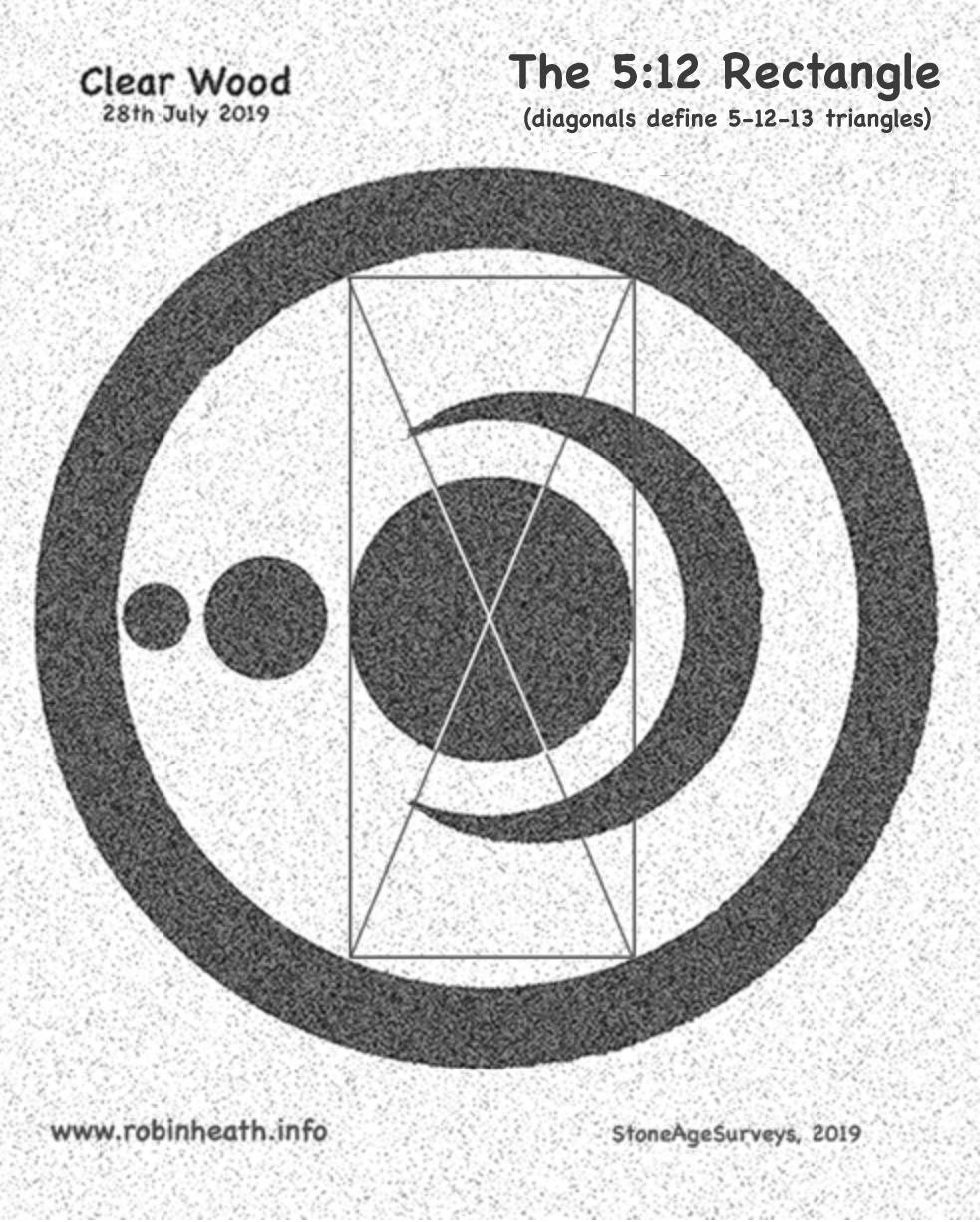
Figure Seven. A rectangle whose side lengths are proportioned in the ratio 5 by 12 connects the central circle with the outer ring. The side lengths are respectively 61.84 and 148.416 feet in length, the two diagonals are each 160.782 feet long. Each ‘horn’ of the lune lies on a diagonal.
THE 5-12-13 TRIANGLES
THE CLEAR WOOD 5-12-13 TRIANGLE
The side lengths as given in the picture caption above.
Perimeter = 61.84 ft + 148.416 ft + 160.782 ft = 371.038 ft
5 units+12 units+13 units = 30 units
The Unit Length of the triangles = Perimeter / 30 = 371.038 ft /30 = 12.368 ft
THE 5-12-13 TRIANGLE AT STONEHENGE
Side lengths, 5 side = 108.88 ft, 12 side = 261.312 ft , 13 side = 283.6 ft
Perimeter = 108.88ft + 261.31ft + 283.10 = 653.28 ft
Unit Length = 652.49 /30 ft = 21.77 ft (8 megalithic yards of 2.722 ft).
THE STONEHENGE PLAN COMPARED WITH CLEAR WOOD
A side-by-side comparison between Stonehenge and the Clear Wood formation is shown below (Figure eight). Despite being less than a week old, and with Stonehenge being more than 4500 years older, these two geometric forms are shown to be closely connected, not only by their geometry but by their metrology and astronomical content, for they both demonstrate a high level of understanding of the marriage of sun and moon, a quality which may interest quite a few people.
The diagonal ’13’ sides of the rectangle are implied by the horns of the ‘lune’.

Figure Eight. Stonehenge and the Clear Wood formation compared. The sarsen circle at Stonehenge becomes the central circle of the crop formation, while the (elliptical) bluestone ‘horseshoe’ is perhaps represented by the ‘grail-cup’ or ‘lune’. The two 5 by 12 rectangles have a relative proportion of 12.368: 21.77, which is 0.56864…- covered later in the text).
CONNECTING SITES ACROSS THE LANDSCAPE
Pythagorean triangles are right-angled triangles whose side lengths are integers (whole numbers) and thus form integer fractions with each other. Megalithic structures,are commonly found to have employed a 3-4-5 or a 5-12-13 Pythagorean triangle either within their design or as a corner or ‘node’ connecting one monument to several others across the landscape. In both cases the triangle supplies the template. This combines number and measurement together, for dividing the perimeter length of a 3-4-5 triangle by 12 (= 3+4+5), will reveal the length of one single unit, now a physical unit of length employed by the builder to represent the base dimension within the side ratios and hence the dimensions of the triangle.
Example One. The example below (Figure nine, overleaf) proves the point well and helps to blow apart some of the worn out prejudices about Neolithic people being savages. Here, three major and well-known megalithic sites, one of which is Stonehenge, are revealed to be connected within an accurate 3-4-5 triangle geometry. Each side of the triangle has a measured length, as listed below,
The 3 side is 102.857 miles long. The 4 side length is 137.10 miles. [3+4+5 = 12 units]
The 5 side length measures 171.4 miles
The Perimeter of the triangle measures 411.429 miles.
UNIT LENGTH = 411.429 miles /12 = 34.286 miles = 240/7 miles.
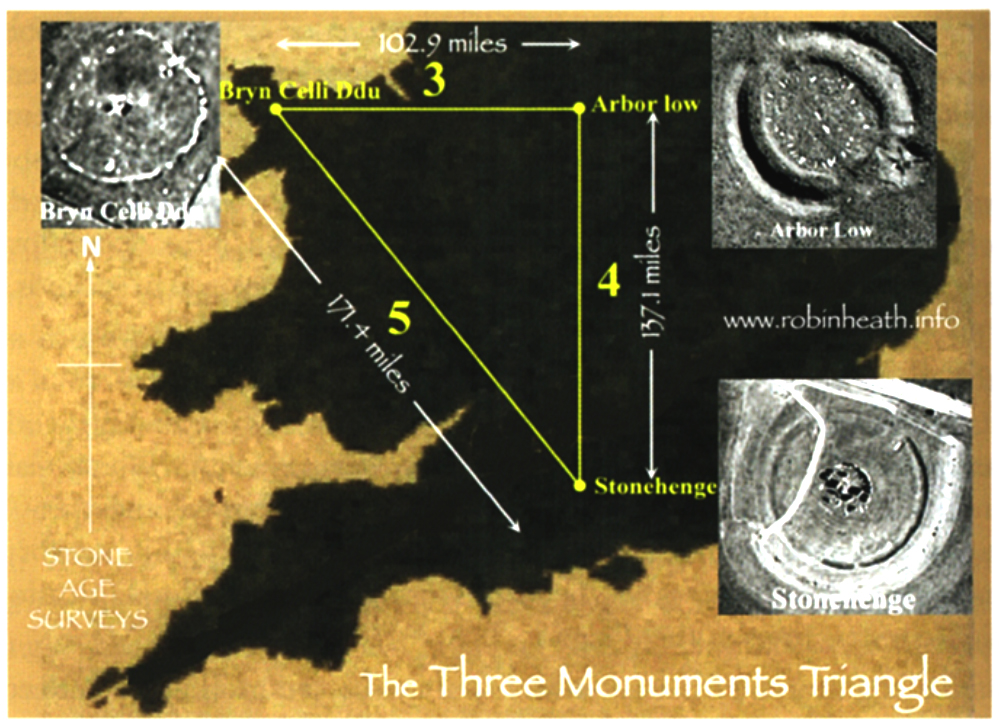
Figure Nine. Three major megalithic sites connected by a 3-4-5 triangle. The unit length is 240/7 miles, or half a geodetic degree (to 99.2%), as shown above.
Example Two. A large 5-12-13 landscape triangle discovered near the Bluestone outcrops in West Wales has side lengths which measure as follows,
5 side = 9,646 feet, 12 side = 23,148 feet, 13 side = 25,078 feet
Perimeter of triangle = 57,873.13 feet. [5 + 12 + 13 = 30 units]
UNIT LENGTH = 57,873.13/30 feet = 1,929.104 feet.
Expressed in units of megalithic fathoms, 1929 feet represents the lunar year or twelve lunar months in days.(354.36708 days). A megalithic fathom is 5.444 feet in length, (two megalithic yards of 2.722 feet in length). Both these units are part of the megalithic ‘family’ of units independently discovered by professor Alexander Thom.
The above example demonstrates the nature of megalithic science as an integrated blend of Astronomy, Geometry and Metrology. Here an astronomical time period is identified directly with the measurement process as lengths of time, when expressed in megalithic fathoms. The above technique can be applied to a 5-12-13 or any other triangle having integer side ratios or simple fractionally related sides.
This technique has transformed my work at megalithic sites, revealing a hidden cargo of astronomical and metrological detail built into many megalithic monuments. This places a whole new raft of practical techniques in front of archaeologists and prehistorians, should they wish to apply it.
This same technique appears to be valid for some crop circles, as for Clear Wood.
CONCLUSIONS
It is clear that Clear Wood is much more than just a large and rather pretty crop circle design that draws on lunar and perhaps planetary symbols. Finding an internal 5-12 rectangle defined within the fundamental geometry of the design suggests this design connects the moon to the sun, as does the number 153 woven in wheat around the outer ring of this formation. This aspect of the geometry of Clear Wood shows it to be a crop circle analogue of Stonehenge, arguably the most important stone circle in Britain, where an identically proportioned station stone rectangle frames the sarsen circle, and connects it to the Aubrey circle.
In this crop circle we have therefore found an essential feature of probably the most famous stone circle in the world, a monument very much concerned with connecting the motions of the moon with those of the sun. The relative proportions of these rectangles are almost in the ratio of 7:4 (as a fraction, 1.76), and the unit lengths of the triangles are respectively 12.368 feet and 8 megalithic yards of 2.722 feet.
A comparison of the longer lengths of the rectangle (the ’12’ side) is most interesting, for Clear Wood measures 148.416 feet and Stonehenge 261 feet, respectively. The decimal fraction is a seemingly endless 0.5686….,*, which will appear to mean absolutely nothing to most mathematicians.
[* My dear friend Pedanticus reminds me that the exact decimal fraction is a geeky 0.5686436781605..]
A Strange Soli-Lunar Brew
This obscure and apparently meaningless fraction has the unlikely and most significant property of converting into a simple whole number fraction (that’s one having a numerator and a denominator), when it becomes,
6184
10875
Decimal fractions, such as 0.56864… (see caption, figure eight) obscure important numerical information and the ‘traditional’ fraction, with a top and bottom line, as per 6184 over 10875, reveals much more of the numerosity of the fractional relationship, and reveals something highly significant to a megalithic scientist. It’s time to find out what. For starters, both 6184 and 10875 are soli-lunar numbers.
The number 6184 is the number of lunar months in five hundred years, and therefore there are 61.84 lunar months in five years, which becomes a (by now) familiar 5 x 12.368 [to 99.998%].
We next turn to the denominator, 10,875, which is similarly redolent with astro-numerical meaning, for it is one thousandth of 10.875 (days)- the annual lunar over-run in days. Expressed in units of lunation periods, this is 0.368.
10.875 days represents the gap between 12 lunar months (354.36708 days) and the period of the solar year, (365.242199 days). Expressed in lunar months it is the by now familiar 0.368 LM*. The reader should note that 0.368 is very closely matched to the fraction 7/19, which is 0.36842.
[Pendanticus tells me the exact figure is 10.875119 days, which divided by the average period for one lunar month gives 0.3682662283, which is 99.9999914% accurate, compared to 10,875 at 99.9989576%.]
There is more funky stuff to be had yet with 61.84. Draw a circle with a diameter of 13 units (your choice), and then construct a pentagram star within it. The five ‘star arms’ will each have a length of 12.364 units (see below), giving a combined length of 61.82 of the same units. The ‘secret’ of the five year repeat soli-lunar calendar can be stored very simply by creating a pentagram star of diameter 13 units, each star arm then has a length of 12.364 units, accurate to 99.97%. A Romano-Celtic example of a five year based soli-lunar calendar may be found in the Coligny calendar. Look it up
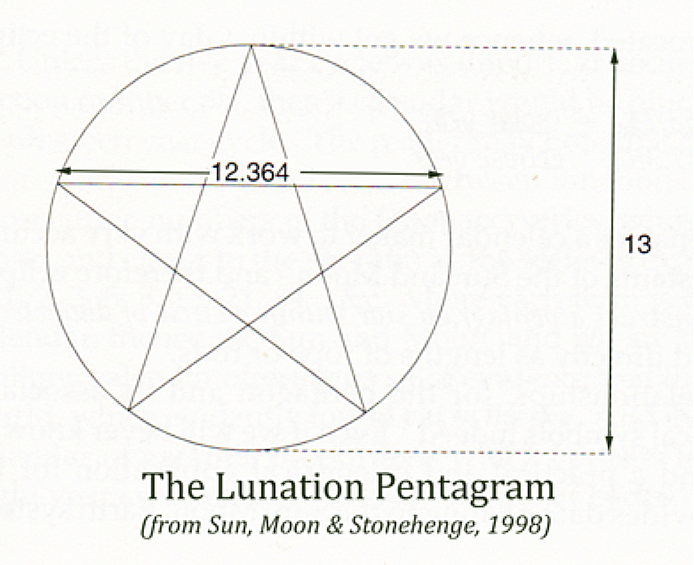
An Even Stranger Geodetic Brew
As a proportion of the ninety degree quadrant from the earth’s equator to its pole, the original decimal fraction delivers a latitude of 0.568644 x 90(degrees) = 51.178 degrees, which is, rather incredibly, within 200 feet of being the latitude of Stonehenge , which is 51.17857 degrees or 51N10’43″degrees.
This rather suggests a reason why Stonehenge was sited where it is. Does it also suggest some kind of ancient cosmic engineering? Thinking it to be a coincidence is the traditional first hiding place of a scientific coward, a too easily applied attribution, partly because something else numerically relevant is going on here, for the traditional fraction of this latitude is 37,104 over 725, and to those that look out for such things, such as my academic friend Pendanticus, one may note that 37.104 is 12.368 x 3, so that in three years there are 37.1047 lunar months. 725 is meanwhile 5 squared x 29, a number long having been associated as a prime ‘lunar number’. We are seemingly swimming in a soli-lunar number soup.
One of the big circles within the outer stone circle at Avebury Henge originally had 29 equally spaced stones defining its perimeter. At Stonehenge there were once 29 equally sized sarsen uprights arranged in the circle. A final half size one (Stone 11 on the official plan) made the numeration up to 29.5, which has been presumed, by many authors, to represent the lunar month of 29.53059 days. Stonehenge contains only two accurate circles, the outer Aubrey circle and the inner Sarsen circle. The outer sarsen diameter (104.416 ft) is 0.368 of the mean Aubrey diameter (283.6 ft).
The dance of the sun and moon is now revealed numerically and geometrically to dance to a very ordered rhythm. The Sun, Moon, Earth system is not the random mechanism attributed to it by modern science. We can found out that our Neolithic ancestors had a rather better knowledge of it than do their prodigal children.
It is important to address the following question carefully and then recognise the implications of one’s answer. It may have something to do with crop circles.
From where did our Neolithic ancestors acquire this impressive knowledge and its associated technology, unless they discovered it for themselves?
SOME CLEAR WOOD MAGIC
The next part of this story has more to do with the consciousness behind this specific crop circle formation in terms of its relationship with megalithic science. We have found within its circular form a 5 by 12 rectangle that connects the inner core of the Clear Wood formation to its outermost ring, just as is found in the station stone rectangle at Stonehenge. But there are also other things that connect this crop circle with Stonehenge. Both sites are related through what I am calling soli-lunar numbers. Each rectangle frames a lunation triangle within itself, whose respective side lengths are related through the fraction
6184
10875
The above scaling factor directly connects the Clear Wood formation and Stonehenge with the principal soli-lunar number, 12.368, through its comprising numbers 6184 and 10.875, these both being lunar-related numbers that contain the ‘secret number ‘of the calendar, the annual lunar month rate of 12.368 lunations. This is no accident, as indicated by the unit length (12.368 feet) of the Clear Wood’s 5-12-13 triangle being numerically identical. The unit length is therefore representing one year expressed in lunations or lunar months.
A return can now be made to the St David’s Triangle, mentioned at the very start of this story and which formed the final slide of my presentation at the Summer Lectures conference.
THE ST DAVID’S TRIANGLE
The newly discovered St David’s triangle in Pembrokeshire, Wales, is much larger than either Stonehenge or Clear Wood, spectacularly so. It’s unit length, at 12,368 ft, is exactly one thousand times the size of the unit length of Clear Wood’s 5-12-13 triangle.
This 5-12-13 triangle has side lengths that measure 148,416ft (12 side), 61,850 ft (5 side) and 160,792 ft (13 side). The observant reader will note immediately that these numbers are numerically almost identical to those lengths measured off the plan of the 5-12-13 triangle within the Clear Wood formation, only they are multiplied by 1,000.
An intermediate hypotenuse, struck between the sharp end of the triangle and the 3:2 point of the ‘5’ side (see earlier on figure three), marks out the solar year as 12.369 lunar months. This geometrical construction (line AD) applied to the Clear Wood formation has a length of 153.0 ft, which is 12,368 x 12.369 and we meet up again with the 153 message contained in the weave of the crop in the outer ring of annulus of Clear Wood. The New Testament mentions this number only once, in the final chapter of St John, where, once the net is cast ‘on the right side’, on Jesus’s advice, 153 fishes are caught by some of his trusted twelve disciples in the ‘draught of fishes’ in the net. They struggle to land such a catch while Jesus stands waiting on the shore. This story may be a written attempt to encode the ‘secret’ of the lunation triangle, as also may the earlier miracle of the five loaves and two fishes.
The St David’s triangle predates the Christian Piscean epoch by perhaps four thousand years, and it has an intermediate hypotenuse length of almost exactly 153,000 ft, a thousand times larger than that of the Clear Wood formation, expressed as 1000 x 12.368 x 12.369 or exactly 152,979 ft (99.986% of 153).
BLUESTONE MAGIC
Today, the apex of this triangle lies in over 20 ft of water, just east of North Bishop rocks, and due west of Whitesands Bay and St David’s Head. This suggests a great age for the structure, the sea levels having risen that much since the structure was built. A diving association is currently being primed to investigate and photograph the sea bed around the estimated location. Among other structures that define this triangle are three similar shaped dolmens, one ‘earth-fast’ one, and the Preseli bluestone outcrop, and these are all estimated by archaeologists to have been constructed on or around 3,000 BC (See figure ten).
The 3:2 point on the ‘5’ side of the St David’s triangle is a most familiar landscape feature to those who study megalithic sites, known throughout the globe, for it is the bluestone outcrop at Carn Menyn in the Preseli Hills (Figure thirteen).

Figure Ten. Three similar dolmens, Llech y Drybedd, Gwal y Filiast and Carreg Samson. The first two each mark a corner of the St David’s triangle, while the third defines a significant position along its ’12’ side, marking the corner of a second 5-12-13 triangle within the other, defined by a line running from Carreg Samson to the Preseli bluestone site at Carn Menyn.
The 3:2 point of this geodetic triangle is the outcrop at Carn Menyn, the source of many of the Stonehenge bluestones. This ‘quarry’ is located high and prominently above the village of Mynachlog Ddu. The final Powerpoint slide of my recent presentation at the Summer lectures revealed all these details (Figure eleven).
The unit length of the smaller incorporated triangle is 7451.4 ft (= perimeter/30) and its size is ‘5’ side = 37,924 ft, ’12’ side is 88,645 ft and the (east-west) ’13’ side is 96.914 ft.
The 153 patterns of the formation’s outer ring circumference can be seen as ‘bait’, a ‘clue’ that invites conscious beings to look deeper into the meaning contained within this formation’s design, and available to anyone who might be capable of investigating this design beyond its immediate geometry and who also understands soli-lunar astronomy and metrology. Previously known as astronomer-priests, such folk are now called megalithic scientists. I’ve been called worse things.

Figure Eleven. The St David’s Triangle.
The selection of relevant presentation slides shown here emphasize the fact that, several days prior to working on my lecture presentation, an almost identical parallel operation was being designed and then laid down in a field near to Clear Wood. In other words, this formation could be thought of as representing a teaching aid for my lecture. It was located in growing wheat, some 13.2 miles from Devizes, without my former knowledge.
This would all be a lot more comfortable for me if the material I was discussing was available in books or on the web, but this simply isn’t the case. I had only just discovered the big St David’s triangle in West Wales earlier this year. It may be several thousand years since anyone was alive who knew what each of its comprising dolmens and other salient monuments involved in its structure were being used for. Until my lecture on Sunday 4th August, I’m pretty sure that nobody else bar myself knew anything at all about it.
This must surely imply one of the following to be true:
- That the circlemaker(s) entered my workshop/office and downloaded my notes and powerpoint display. As the required final slide was completed only late on the Friday, after the circle had appeared, we can probably dismiss this option as silly paranoia.
- That the circlemaker(s) have the ability to read my mind (and presumably yours!) and knew exactly what I was doing, and why, while preparing this lecture. This appears to be true, and engendered a not so silly paranoia. If true, then one needs to be more careful about what one is thinking about, become more mindful!
- That a third force decided that it is time to re-introduce the human race to the ancient art of integrating astronomy, geometry and metrology (i.e. megalithic science) to a wider public, and both I and the circlemakers of Clear Wood, who clearly weren’t farmers with ropes and planks, were thereby impelled to act on or align to the required zeitgeist. Both my lecture and the crop circle formation at Clear Wood then represent a precis, identifying and then celebrating the zenith of the megalithic builder’s knowledge, capability and skill, by distributing this knowledge to a larger audience.
Choice number three eventually became my considered choice. I can live with this one, for I have been tuned into this particular zeitgeist for many years. Readers can, of course, make up their own minds on the matter, or better still, come up with further information. Whatever, I believe that the measurements here can be relied on and will provide hard evidence to uphold any future work.
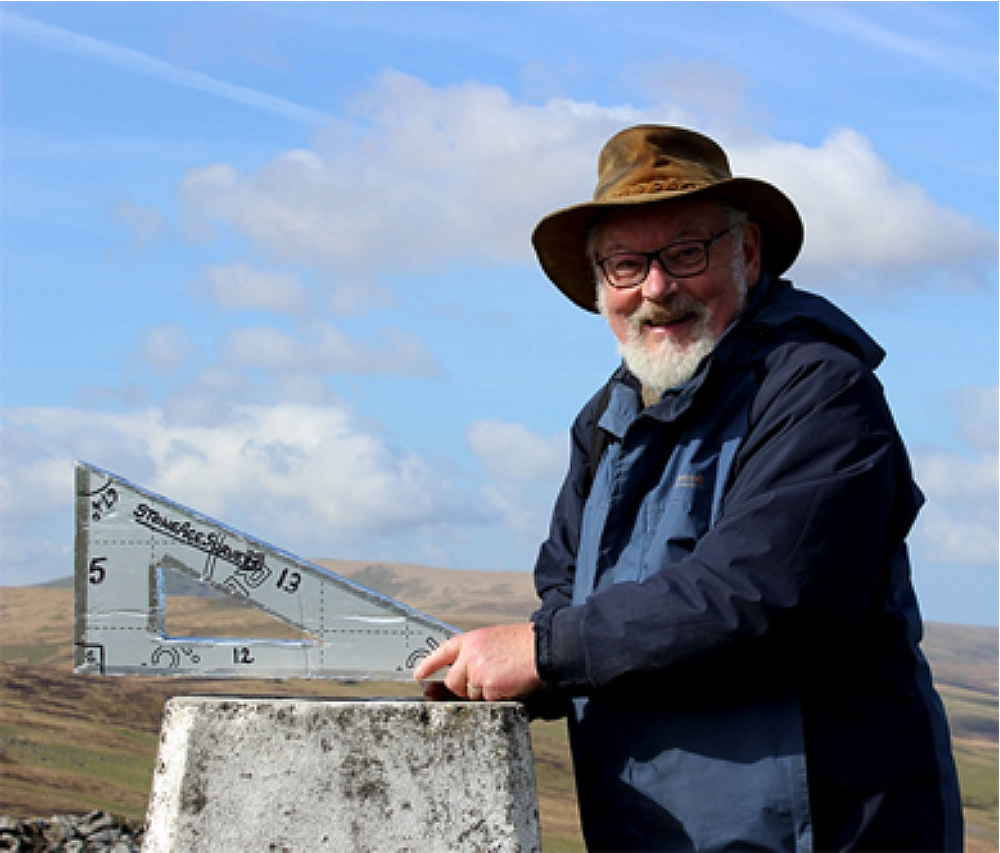
Figure Twelve. On top of things in the Preseli Hills, March 2019.
This report reveals that the old stone circles and the more recent crop circle phenomenon have much in common, perhaps unexpectedly. But there is much else that the reader can chew on here. Both are temples to ancient Deities, although the crop circles may owe their existence to some new and highly technological gods. The same can also be said of another now famous crop formation, that known as Crooked Soley. It also held all this information in units of feet. In their book of the same title, authors Allan Brown and John Michell (2005, Roundhill Press) skillfully identified that this formation was filled with Plato’s number symbolism, the design containing both the size of the earth and the design of earthly temples, together with a representation of Mitochondrial DNA within in its central pattern. There is much other strangeness associated with the Crooked Soley formation, its design and its location, a matter discussed in depth by Patrick Harper in the book’s concluding chapter. In time the Clear Wood formation may be seen in the same light, as another manifestation of Mercurius in the cornfield (meets chronos at the stones!).
Crooked Soley needs to be talked about much more. A profound object, its design was nearly lost to us, harvested only minutes after Steve Alexander photographed it. Many people have since made the assumption that Michell and/or Brown must have had a hand in its construction. This is too easy or too comfortable a solution for the many largely inexplicable issues presented by the formation, and it belittles the formation as well as the impeccably qualified researchers who investigated it.
As for the St David’s triangle, I may be getting older but I not sufficiently to have put into place the dolmens and natural outcrops that provide its physical reality. The measurements here that spill out from using a theodolite and Google Earth, are not from my head. The sun and the moon do indeed behave in the manner described, and have done so since long before humans first walked on this planet. Finally I wasn’t in Wiltshire on Thursday 28th July to fabricate the Clear Wood formation. I was at home in West Wales and I have alibis! And anyway, I could not have performed this task even had I wanted to.
Both these formations, Crooked Soley and Clear Wood, are seriously active and powerful Mandalas. Only the Clear Wood formation contains many of the secrets of the stone circle builders. This connection has not been abstractly plucked out of thin air, for in all manner of ways the design emulates the key connections between the Sarsen circle and the Aubrey circle at Stonehenge, through a connecting 5-12-13 triangle, and I have also identified a 1000 times larger copy of Clear Wood from a similar, very much larger and very ancient triangular structure, spread out across much of Pembrokeshire.
Clear Wood circle’s function therefore sits very comfortably under the umbrella of traditional megalithic science, for this formation also demonstrates soli-lunar astronomy through the employment of geometry and metrology. This article may go some way to promoting the remarkable things going on in this crop formation, as well as introducing the reader to the astonishingly vibrant material from our distant past that is being slowly but consistently rediscovered up in the Preseli Hills in West Wales, after maybe four thousand years of being forgotten. Boy, have I had some fun up there – you would not believe how much!?
Here is a newly revealed connection between stone and crop circles, the old and the new, a definitive statement of factual relevance to today’s world, a zeitgeist or portent of the future development of both the crop circle phenomenon and megalithic science. It’s time to get wise!
Robin Heath, August 27th 2019

Robin Heath asserts his moral rights to be identified as the sole author of this report under the Copyright & Data Protection Act, 1988.
The copyright for this article is registered with Bluestone Press, August 2019. Extracts and quotations of less than 500 words, taken directly from this document and intended for private use or for further publications, are welcomed, providing acknowledgement is given as to the source of the material quoted or otherwise used. No part of this document may be copied or otherwise reproduced by mechanical means without first making an agreement with the publisher, who may be contacted in writing at the following address. Bluestone Press, The Old Post Office, Glanrhyd, Cardigan, Pembrokeshire. SA43 3PA. Permissions for reproducing any of the pictorial content is via the above website. Anyone in any doubt as to copyright terms and conditions should contact the author.
Copyright of the images in this article are either to Robin Heath, or are otherwise attributed.
Robin Heath is an independent researcher into the surviving evidence that supports those ancient sciences that modern scientists have chosen to ignore, for whatever reasons. Once a research scientist in semiconductors, he became a lecturer in electronics and mathematics in further education, before taking up his present work. He lives in coastal West Wales with his wife Trish. Robin may be contacted via his website www.robinheath.info.
Books by Robin Heath available on our online shop…
We have a selection of Robin’s great books on our online shop – click on the picture for more info…


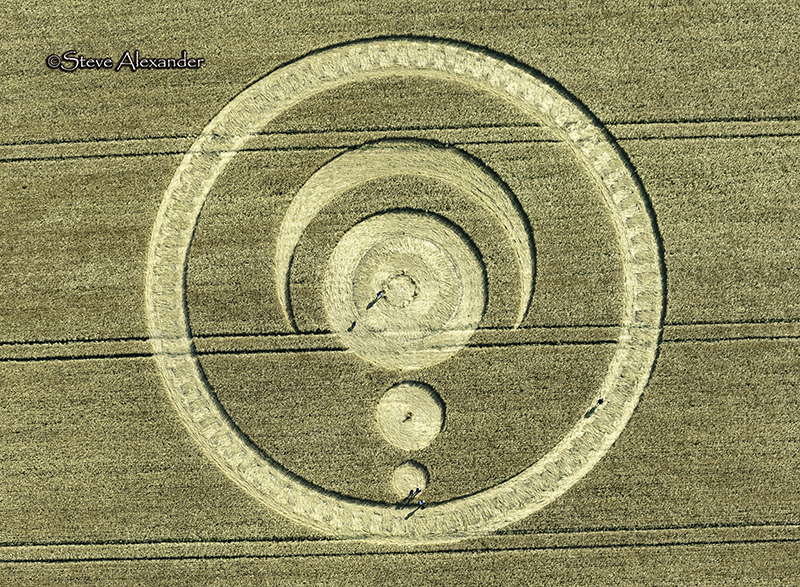
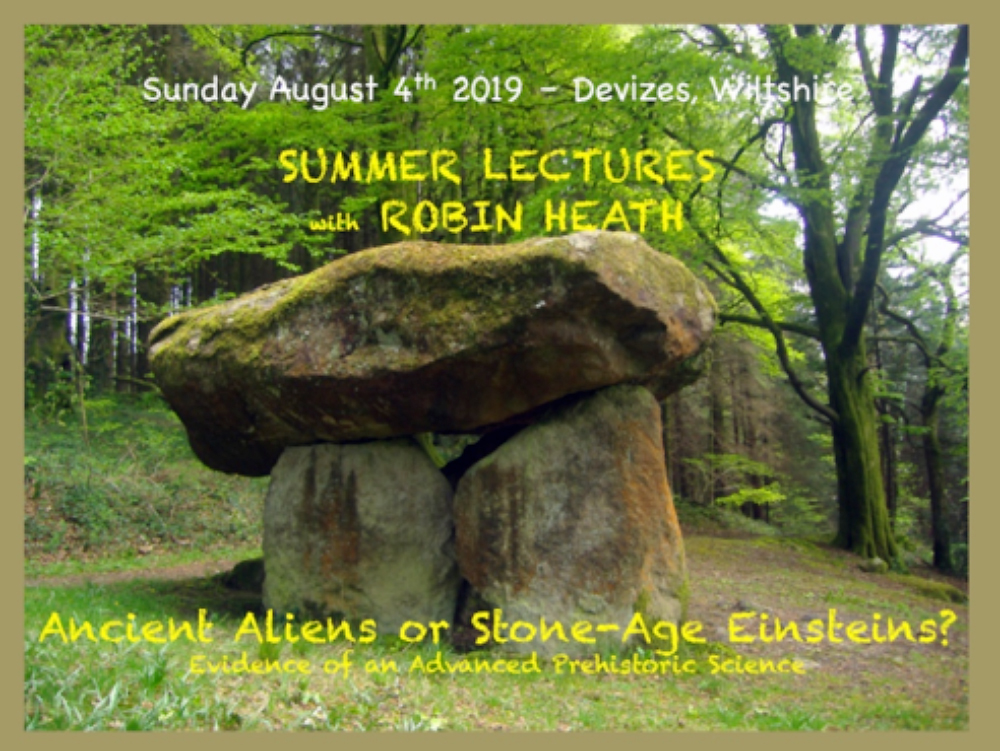

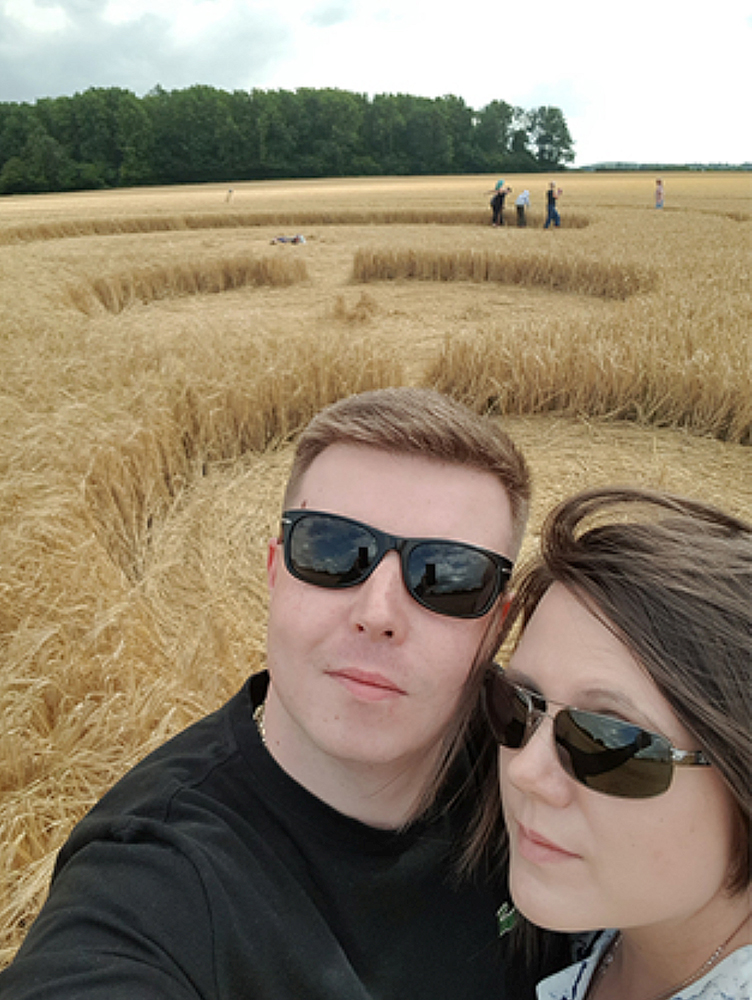

Recent Comments